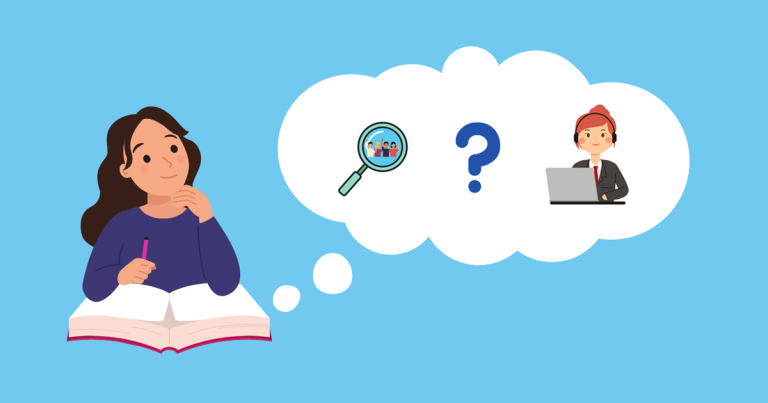Agent self-evaluation enables customer care representatives to review their own performance. In the process of reflecting upon personal performance goals, customer feedback can be used as an invaluable resource. That is because feedback is the most straight forward way to understand how well an agent is doing their job in terms of meeting client needs.
In this article, we’ll explore how support representatives can use customer feedback as a self-evaluation tool.
What is Agent Self-Evaluation?
An agent self-evaluation, or self-assessment, is a process in which agents rate and review their work using a form a third-party evaluator may use. Self-evaluations motivate staff members to assess and enhance their performance.
A customer feedback aided self-evaluation employs the agent’s perspective and insight, statistics, and customer feedback to assess an agent’s performance.
Customer feedback as a tool for agent self-evaluation
Feedback provides a window into customers’ considerations, feelings, or experiences. Agents need access to this information to enhance efficiency, understand their influence on the consumers’ brand experience, and deliver better support. Additionally, customer feedback represents a qualitative metric which can be used along quantitative KPIs to offer a holistic and accurate understanding of individual performance both by agents and their managers.
Promotes Personal Growth
Customer feedback is a fantastic tool for encouraging personal development. Feedback lets you defend your choice and clarify your position to candidates. Most of the time, candidates will appreciate the comments because it will help them grow personally.
Supports Agent Self-Assessment
Customer feedback can help agents evaluate their performance in serving clients by giving them information about how well they are doing their jobs. Encouraging agents to self-evaluate can allow them to reflect on their accomplishments, conduct an analysis, and compile evidence supporting their contributions to the company’s expansion.
Highlights the Importance of Continuous Improvement in Customer Service
Customer feedback is crucial for determining how satisfied your present customers are. It impacts innovations and modifications to the product or service and informs your decision-making. Additionally, it gives your product team original comments on aesthetics, functionality, and application cases.
Leveraging Customer Feedback for Agent Development
Agents will work more effectively and enthusiastically when they have all the resources they need to do so. Ideally, this includes having centralized technologies that gather all relevant aspects of client data in one location.
Identifying Agents’ Strengths and Weaknesses
There are numerous approaches to using feedback to determine the strengths and limitations of agents. Utilizing agent scorecards and quality assurance is one method. This might assist you in choosing the contact centers and each agent’s strengths and limitations. You can begin training agents and create training objectives and success metrics.
Gaining Insights into Customer Perceptions and Experiences
For organizations to understand consumer opinions and experiences, client feedback is crucial. Businesses can use it to discover behavioral trends and boost the efficiency of their marketing, sales, and customer service operations.
When appropriately used, consumer feedback information can improve product development, increase conversions, and foster a great customer experience. Businesses that use consumer behavior to get insights to surpass competitors experience sales growth by 85%.
Enhancing Skills and Performance Through Feedback-Driven Learning
Through feedback-driven learning, customer feedback can improve skills and performance in several ways. It can assist support teams in developing their abilities by offering comprehensive data about rep performance and ensuring their support staff can assist customers in succeeding.
Customer feedback can also assist you to draw in new clients and gain a deeper understanding of your audience.
Self-Reflection and Performance Enhancement
Customer feedback can aid in self-reflection and performance improvement by boosting self-awareness, self-regulation, and self-efficacy. Self-awareness refers to understanding your feelings, ideas, and behaviors and how they impact your results.
Encouraging Agents to Reflect on Their Interactions
Any business can benefit from customer feedback because it identifies areas for improvement and highlights those areas where a business succeeds. Encouraging agents to evaluate their interactions with consumers and pinpoint areas for improvement can also be helpful.
Agents can correct their errors and become better performers in the future by receiving feedback. It results in better client satisfaction and loyalty.
Identifying Areas for Improvement Based on Feedback
You can include consumer input into longer-term company roadmaps to help you find ways to enhance your goods and services and identify new client requirements or chances for innovation.
According to the 2022 Global Consumer research, 60% of consumers stated they were 3.5 times more likely to purchase from a company following a pleasant service experience.
It can also help you locate unhappy clients with whom you can strike up a conversation and alter the trajectory of your relationship. You can learn about their problems and find potential areas for operation development by listening to what they say about their condition.
Setting Personal Development Goals and Action Plans
Customer feedback is a valuable resource for self-improvement. You can utilize feedback to discover your abilities and shortcomings and create action plans and goals for your personal development. Knowing what needs improvement can help you make a plan that suits your requirements and objectives.
Building Empathy and Customer-Oriented Mindset
Any firm must use customer feedback to develop empathy and a customer-focused mindset. Businesses that actively listen to client input can spot habits and patterns that need improvement.
Developing A Deep Understanding of Customer Needs
Statista reveals that 27% of US customers cite slow customer service as the main reason for their annoyance.
Businesses can gain a thorough grasp of client needs by collecting customer feedback. With a greater understanding of their customers’ wants and expectations, firms may enhance their goods and services. Businesses can use it to pinpoint areas where their customer service needs work.
Enhancing Empathy and Rapport with Customers
Customer feedback is vital for better communication with and satisfying customers. A possible method for expressing empathy and building connections across cultural and linguistic barriers is to ask your customers for feedback. You can seek input and ideas from your customers on how you might better meet their needs.
Cultivating A Customer-Centric Approach in Agent Interactions
Customer feedback is essential for developing a customer-centric mindset in agent interactions. Gathering consumer feedback is crucial because it can improve every element of your business if you pay attention to it.
Strengthening Communication and Problem-Solving Skills
Using client feedback to improve communication and problem-solving is crucial to offering first-rate customer service. Coursera reveals that effective problem-solving, communication, and empathy are essential to successful customer service.
Improving Communication Effectiveness
An essential technique for enhancing communication efficacy is customer feedback. It gives you helpful information on how clients view your company and how to improve your communication tactics. By getting client feedback, you may spot any gaps in communication and make changes to serve their demands better.
Enhancing Problem-Solving Abilities
By highlighting issues, potential areas for improvement, or shortcomings in your company, customer feedback can aid in improving problem-solving skills. It may also reveal how clients view your company.
In addition, problem-solving abilities, including flexibility, communication, analysis, emotional intelligence, creativity, resilience, and teamwork, can make you a better leader.
Nurturing Critical Thinking and Adaptability
Businesses may pinpoint areas that require improvement and implement adjustments as necessary by paying attention to client input. By pushing them to evaluate their goods and services critically and modify them to satisfy client needs, this technique can support organizations in developing critical thinking and flexibility.
Recognizing Achievements and Motivating Agents
An essential component of any firm is rewarding employees for their accomplishments and inspiring them through feedback. A Harvard Business Review study found that giving people in-person praise is frequently an affordable approach to encourage the entire company.
Highlighting Positive Feedback as A Source of Motivation
Employees can get a lot of inspiration from customer comments. Giving employees encouraging feedback might make them feel valued and appreciated for their job. This may result in increased motivation and job satisfaction. Motivated employees will work well and offer superior customer service. Customer happiness and loyalty may rise as a result of this.
Celebrating Agents’ Successes and Exemplary Performance
Customer feedback is the knowledge, opinions, concerns, and suggestions that members of your community have expressed regarding their interactions with your business, goods, or services. Even when unfavorable, this feedback can inspire good change in any firm by guiding changes to the customer experience.
Everyone benefits when businesses use customer feedback to improve the customer experience. It aids in providing excellent customer service and recognizing agents’ accomplishments and superior performance.
Encouraging A Positive Work Environment
Feedback is a strategy for supporting team members’ behavioral shifts and reinforcing positive conduct in the workplace. Constructive criticism on areas for growth is advantageous to offer and hear, but it is also essential to use positive comments to promote a positive environment.
Overcoming Challenges and Addressing Negative Feedback
It can be challenging to overcome obstacles and deal with unfavorable criticism, but it is crucial to understand how to do so. Here’s how representatives may use criticism to their advantage.
Handling Constructive Criticism and Negative Feedback Gracefully
Harvard Business Review advises putting negative criticism in its proper perspective and keeping it in view while receiving it.
Act professionally when you receive unfavorable feedback. Transform negative feedback into constructive criticism, and draw out the positive suggestions hidden beneath the negative language. Always consider negative reviews as teaching opportunities, but do not let one or two bad reviews get the better of you in the face of a sea of positive feedback.
Turning Negative Feedback into Learning Opportunities
Customer opinions are a crucial component of any organization. Negative criticism can be challenging to handle. However, it also offers a chance for growth and learning. Following are some strategies for using customer feedback to transform unfavorable remarks into teaching moments:
- Listen carefully – Pay close attention to the customer’s comments and try to comprehend them from their point of view. This will assist you in determining the issue’s underlying cause.
- React quickly – Quickly addressing client complaints demonstrates your concern for them and your dedication to finding solutions. 60% of customers are willing to consider AI in customer engagement because it helps speed up problem-solving. Therefore, agents must act promptly.
- Take responsibility – Admit fault for the problem and, if required, extend an apology. Your clients will become more trusting as a result.
- Make improvements based on feedback – Take the chance presented by negative comments to enhance your offering. This will enable you to spot problem areas and make the necessary adjustments.
- Follow up – After fixing the issue, check in with the client to see if they are happy with the outcome.
Providing Support and Resources for Agents’ Development
Customer feedback is crucial for organizations because it lets them identify their strengths and weaknesses. It identifies areas where representatives are having difficulty and where they need more training when offering support and resources for their development. Additionally, it can pinpoint the areas in which specific agents stand out and can serve as role models for other agents.
Integrating Feedback into Performance Evaluation Processes
Employee management includes incorporating input into the performance review procedures. It gives workers an organized strategy for progress while also assisting them in understanding their unique abilities and shortcomings.
Incorporating Customer Feedback into Performance Assessments
There are various ways to use customer feedback to enhance performance evaluations. Given the precise data it offers on rep performance, it helps support teams improve their abilities and ensure they can assist clients in succeeding.
Customer feedback can gauge customer happiness, a crucial element in determining an organization’s financial performance.
Balancing Performance Metrics with Qualitative Feedback
Customer feedback can strike a balance between quantitative performance measures and qualitative feedback by revealing how customers see the good or service. It can better understand client wants and expectations and point out areas that need improvement. Businesses can make data-based choices to enhance their goods and services by evaluating client feedback to find trends and patterns.
Using Feedback to Inform Training and Coaching Programs
Coaching and training programs can benefit from using customer feedback in various ways. Utilizing client feedback is one technique to determine what areas of employee training are lacking. For instance, if customers frequently voice concerns about a particular problem, such as poor communication abilities, or prolonged wait times, this may be a sign that staff members require further training in these areas.
Utilizing client feedback is another method for assessing the success of coaching and training initiatives. Organizations can ascertain whether coaching or training successfully raised client retention by gathering consumer feedback once staff has received the appropriate instruction.
The Bottom Line
Businesses might transform by doing self-evaluation using client feedback. It is a method of consciously evaluating how well you accomplish your job serving your clients. While your manager may give you a separate review, a self-evaluation considers your viewpoint, insight, facts, and client feedback.
Utilize customer feedback to get the most out of your customer feedback plan. Customer feedback is data a company gathers about the preferences and experiences of its consumers with a product or service directly from them. Customers can express their ideas through interviews, surveys, and other means to let a business know if they are happy or unhappy.
Did you like the post?
You might also like:

Surveypal
Everything you need to lead and improve your customer experience. Learn more at surveypal.com, or







